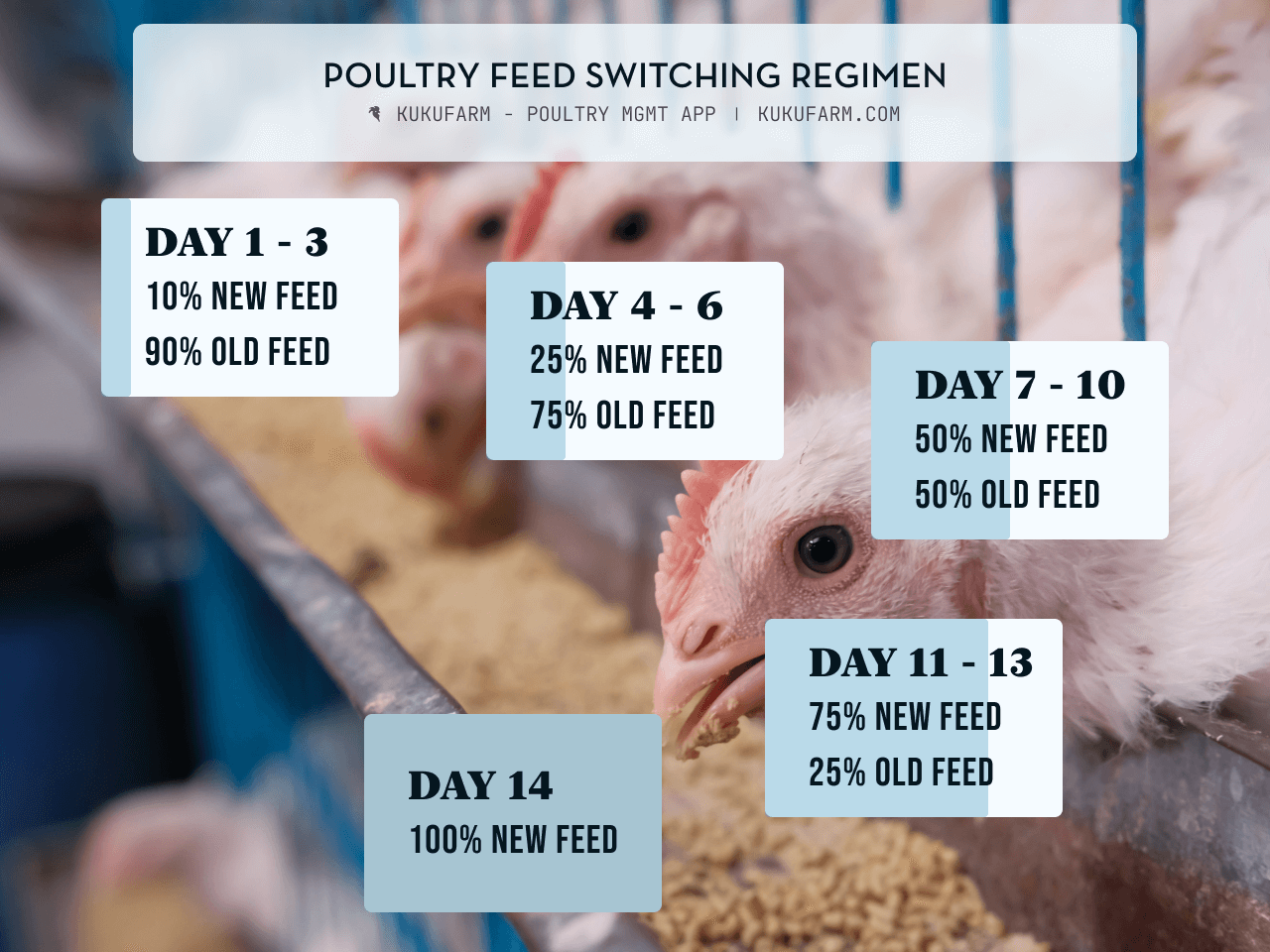Poultry feed switching is an important event in poultry farming. Essentially, at every poultry feed switching event, you switching a flock from one type of feed to another.
For both layers and broiler flocks, feeding switching is essential as chicken mature and require different feed for the purpose of growth and productivity. Generally, layers and broiler flocks have 2 feed switching occasions. This is revisited later in the article.
Ideally, implement poultry feed switching gradually to avoid stressing your flock. Instant feed switching will likely result to delayed or loss of production. Furthermore, it can result to inability of your flock to achieve and maintain expected weight.
You may also be interested in other uses of a poultry flock feeding schedule.
Poultry feeding switching regimen
As we have mentioned above, both layers and broiler flocks have at least 2 feed switching events during their lifetime. However, feed switching for layers and broiler flocks are completely different. They happen at different times, and different feed types are used.
Additionally, although both layers and broilers have growers in their feeding schedule, this are usually specially and exclusively made for layers and broilers respectively.
Nonetheless, when switching from one type of feed to another, it is important to do so gradually to avoid stressing your flock. You can implement a poultry feed switching regimen ranging from 9 – 15 days. Below is a sample 14 day feed switching regimen.

When to use a poultry feed switching regimen
There are at least 2 particular occasions when you have to use a feed switching regimen.
Switching from one feed type to another
The most obvious occasion when you need to implement a suitable feed switching regimen is when your flock go from one feed type to another. For instance, when switching from starter or chickmash to growers feeds.

In general, both layers and broiler flocks have at least 2 feed switching occasions. A layers feeding schedule prescribes 3 feed types outlining 2 feed switches: From starter / chickmash to growers mash, and from growers mash to layers.

Similarly, a broiler flock feeding schedule prescribes 3 feed types and thus 2 feed switching events: From starter / chickmash to growers and from growers to finisher.
When continuing with the same feed type but switching feed suppliers
The second situation in which you need to implement a feed switching regimen is when you are continuing with the same feed type but switching feed suppliers.
So, let’s say your flock is on growers mash, and you have started buying feeds from supplier B, from supplier A.
Most likely, feeds from different suppliers will have different ingredients. Furthermore, different suppliers will use different feed formulas to produce the same feed type. Consequently, no two feeds from different suppliers can be the same.
It is therefore important to implement a suitable feed switching regimen for your flock if you switch feed suppliers.
Pros of a feed switching regimen
There are at least 2 reasons why implementing a feed switching regimen is essential.
The first reason you will want to implement a feed switching regimen is to minimize if not avoid stressing your flock. If you implement instant feed switching, your flock will most likely become stressed.
A stressed flock will have delayed growth or start of egg production cycle. For a flock that is already producing eggs, instant feed switching can result to stoppage of egg production.
From our experience and conversations with other poultry farmers, delayed or loss of egg production, is the main issue with layers flocks.
Furthermore, for broiler flocks, instant feed switching can result to delayed weight gain or even stunted growth.
The second reason you should implement a poultry feeding schedule is to ensure optimal continuity of flock growth and productivity. A proper feed switching regimen will ensure that your flock’s growth and productivity are not interrupted. That is, imminent or existing egg production are timely and continue respectively. Additionally, scheduled weight gains and maintenance are achieved.
Key takeaways
- For optimal flock health and productivity, implement feeding schedule as prescribed by your flock supplier
- You can use a 9 – 15 day feed switching regimen for your flock
- Improper feed switching can stress your flock and result to slow growth or delayed start of egg production
- Additionally, if you are switching feed suppliers, but still on the same feed type, gradual switching is recommended
- If unsure how to implement feed switching regimen to your flock, consult your flock supplier or certified vet
- Ensure your poultry feed are of high quality

